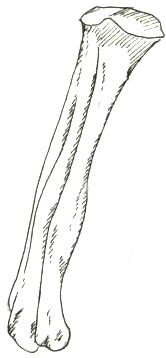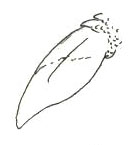
ENANTIORNITHES In RL, the gondwanan forms of bird life (known to most of us as "normal" birds) were given a decisive edge when the Chixulab boloid hit the Yucatan. The impact started a chain of events that not only killed every large animal all over the planet, but most small animals in the Northern Hemisphere, where the choking clouds of ash were the thickest. Many Eurasian and North American small animals (the multituberculates, for instance) were decimated by the calamity, but the worst hit were the Laurasian toothed birds, the enantiorniths.
In Spec, of course, none of this business ever occurred.
At the dawn of the Tertiary, most of the bird life in North America was enantiornithian, composed of birds which possessed both teeth and manual digits. These birds proliferated in North America and Eurasia throughout the Cretaceous, but by the beginning of the Tertiary, the Gondwanan landmass had already broken up, and pieces of the great continent (Africa and South America) had connected to the Laursian landmass to the North. Gondwanan euornithians (true birds) swept northward, beginning a long war for domination of the skies.
By the Eocene, true birds had already conquered most of their counterparts' niches. Fossils from Eocene Germany show a large diversity of enornithians including coraciiforms (kingfishers, pickpeckers, etc.), piciforms (barbets, rollers, etc.), and twitiaviforms (tweeties, scytherbills, etc.) demonstrating that these birds had already risen to dominance only 15 million years after the end of the Mesozoic.
By the present day, successive waves of Gondwanan invasions have reduced Laurasian diversity to a mere fraction of its former glory. Enantiornithians now exist in specialized niches scattered throughout Laurasia. In Eurasia, the clade's diversity is rather higher, but North America does boast a few species of the ancient laurasiavian radiation.
LAURASIAVIFORMES
Throughout the history of the Cenozoic, the story of bird life in North America has been one of conquest. Invaders from Eurasia or South America have, again and again, swept over the neararctic, replacing the natives and then going native themselves, only to be replaced, in turn, by the next wave. There are, however, always survivors from prior ages, living fossils that continue to exist under the shadow of the new regime by dint of isolation or extreme specialization. One of these relic groups is Laurasiaves, a once-mighty enantiornithian clade now relegated to a few endemic species in the warmer parts of North and Central America.Laurasiavians are a group of enantiornithians and thus branched off from true birds quite early in their evolution, either in the Jurassic or early Cretaceous. As such, laurasiavians resemble true birds, but their internal anatomy is so fundamentally strange that one is at a loss when considering where to begin their description. Perhaps their ankles would be best.
Laurasiavians are easily identifiable their ankles (the namesake of Enantiornithes or 'opposite birds') in which the three metatarsal bones are not fused bottom-to-top as in true birds, but top to bottom. This feature, common to all enantiornithian clades, is a fundamental difference between these birds and the euornithians.

(Picture by Daniel Bensen)Fig. 1: Right metatarsus of green bunglebird (Xenosornis veridigenalis). Note fusion of bones at top, rather than base.In most respects of their skeletal systems, laurasiavians are typical enantiornithians, but for their heads and their hands. The skull of a laurasiavian is heavily built, with a crushing, toothless beak. Indeed, on first glance, a laurasiavian could almost be mistaken for one of the long-extinct confuciusorniforms.Fig. 3: Skull of typical xenosornid, the green bunglebird. Note the primitive, robust construction.

(Picture by Daniel Bensen)Fig. 2: Left aileron of green bunglebirdIn the rest of their anatomy, laurasiavians are typical enantiornithians, with swept-back (though still keeled) sterna, relatively long tails, and primitive hips with the pubis and ischium fully separated.Laurasiaviformes was quite diverse during the Eocene and in modern Eurasia they occupy a number of clades, but in North America, only one branch of the tree is left, the xenosornids.
Xenosornidae
The xenosornids (bunglebirds) inhabit warm, humid environments across southern North America and Central America. These are medium-to-large (never smaller than twenty centimeters) birds that superficially resemble parrots. The bulk of a bunglebird's diet is fruit and nuts, with very occasional forays into insects or flower-munching. These birds face increasing competition from the true parrots as well as (in the more southern parts of their range) the frugivorous arbrorynchids.
Back to SpecSAMPLE TAXA:(Text by Daniel Bensen)